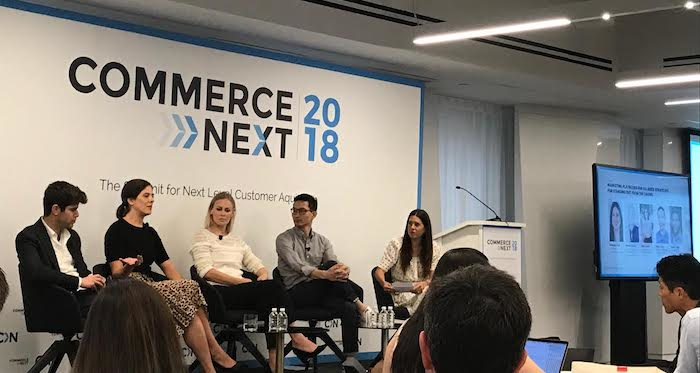At CommerceNext, major retailers from different industries shared their secrets on how they work to disrupt their processes and work towards improving their strategies in the digital age. Here are seven of the biggest takeaways, from seven very different brands:
Click here for more CommerceNext coverage
Levis: Re-imagining the brick-and-mortar
Levi’s is a legacy brand with more than 100 years of brick-and-mortar history. But changing demand called for a new approach to their floorsets — one that kept the customer at top-of-mind.
“Our stores had to be more,” Carrie Ask, EVP of global retail, Levi’s, said. “They had to be more engaging, more innovative, more compelling.”
According to Ask, Levi’s took a risk when reimaging the layout of their Soho, New York City, flagship. The store’s large cashier station was downsized and moved from the center of the store, to allowed customers to “see the product first.” Some of the registers were replaced with self-serve checkout kiosks to give shoppers the option of a speedier payment process. Dedicated space was created to a custom tailor shop, where customers could have their items personalized and embroidered. And Levi’s doubled the size of their dressing room space, sacrificing room for inventory, so that customers could have a more comfortable fitting room experience.
The renovations were fueled by research, and the end product paid off. The store launched with a social-media fueled bash, and overwhelming positive response, Ask says.
“We needed to meet the them [the customers] where they are,” Ask said. “We needed to speak their language.”
Footlocker: Communicating Across Generations
Footlocker took a similar approach to their brick-and-mortar flagship layout. For the athletic shoe retailer, innovation crossed channels, and tapped into the “sneakerhead” culture embraced by their core demographic — Millennials and Gen Z shoppers.
“It’s not really about the shoes themselves — it’s about the experience,” Vijay Talwar, president, digital, Footlocker, said.
Footlocker turned to gamification and social media to make shoe discovery a more engaging experience. The retailer also teamed with Afterpay to make the payment process more accessible to younger demographics by breaking down what would be an expensive luxury purchase into monthly installments, interest-free. This opens up a new way to pay, without the fear of racking up interest.
“It takes out another hurdle [for shoppers], Talwar said.
Related: Creating New Retail Experiences With Social Gamification
Thirdlove: Listening to customers
Thirdlove is a direct-to-consumer women’s lingerie brand that prides itself on providing a completely customizable experience for customers. Thirdlove carries 70 different styles and fits (almost twice their largest competitor, according to Ra’el Cohen, CCO, Thirdlove). When you enter the Thirdlove site, customers are prompted to take a quiz to identify the biggest issues they have with their current bra, along with their ideal fit. Once the quiz is completed, customers are given a custom selection of fits and styles that best match their responses.
According to Cohen, the approach is to help alleviate the often stressful shopping experience associated with searching for the right everyday piece of lingerie. Because Thirdlove is D2C and completely online, the brand has the ability to manage a wider selection of available inventory — something that can be a logistical issue for traditional brick-and-mortars.
Thirdlove also takes customer feedback into account. Cohen gave the example of a middle-aged woman who contacted the brand after purchasing one of their products. The customer gave a rave review, but noted that women of her age weren’t represented in their marketing. Cohen and her team invited her down to the Thirdlove office to chat with different departments, and learn how they could meet her needs. And, Cohen says, she’ll be making a debut in their marketing campaigns later this year.
“She cared enough about our brand to want to make us better,” Cohen said.
Qurate Retail Group: Turning to social media
Qurate, the parent company of QVC, HSN and Zulily, took at different approach to connecting with customers — tapping into social media.
“The pace of change is so astounding, it can be overwhelming or exhausting to figure out which way to go,” Naomi Jacobs, director of social media strategy, Qurate, said.
QVC is known for bringing the shopping experience into the home long before there was digital channels. Now, the company is creating the same experience on social, through Facebook live.
“It’s so incredibly powerful to connect with customers through live content,” Jacobs said.
Download our eBook: What’s Next In High-Tech Retail?
Away: Making sense of data
For Away, understanding customer data plays an important role when constructing campaigns.
According to Mark Chou, VP, growth marketing/eCommerce, Away worked to aggregate data in a “consolidated way” to help better track attribution — one of the biggest problems eCommerce brands face when marketing on multiple channels.
“Being able to aggregate data into one data warehouse has been extremely helpful,” Chou said.
Ulta: Putting customers first
For Prama Bhatt, SVP, digital and eCommerce, Ulta, data and tech partners are viewed as a secondary tool — one that works as a support system for lifting the overall brand mission.
“We think less about how to become innovative, but…how we can improve on our own [brand] DNA…so that key idea isn’t lost at scale,” Bhatt said. “Ultimately, it’s about taking tech and building out an experience.”
“Sometimes, it’s not about the breakthrough idea, it’s about finding perseverance,” she added.
1-800-Flowers: Embracing Disruption
Amit Shah, CMO, 1-800-Flowers, urged brands to shake from the norm, and not be afraid to take risks. The biggest thing holding brands back from excelling can often be fear, or pushback from upper management who are unwilling to move from “business as usual.”
“When it actually comes to the meat and bones, it’s about disruption…it’s uncomfortable,” Shah said.







